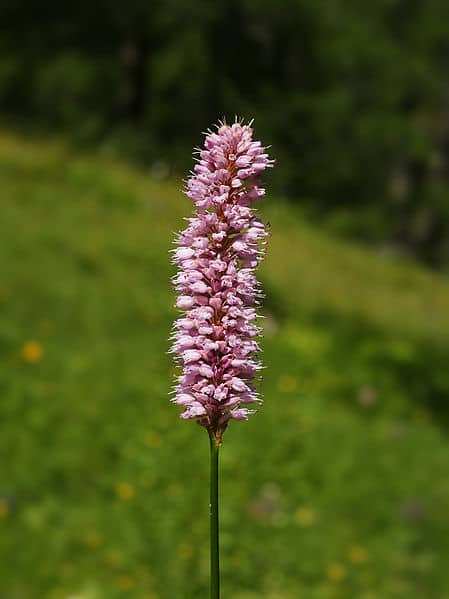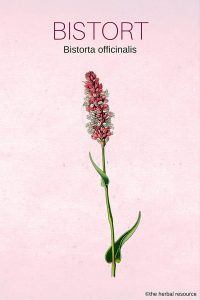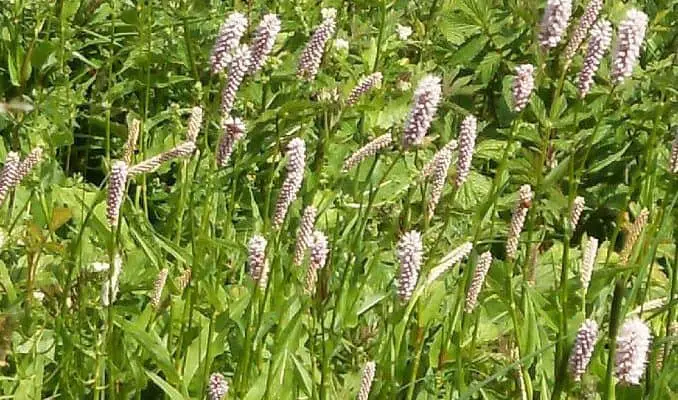Botanical Name: Bistorta officinalis, Polygonum bistorta.
Other Common Names: Common bistort, snakeweed, poor man’s cabbage, snakeroot, oderwort, meadow bistort, adderwort, osterick, pink pokers, English serpentary, dragonwort, Easter mangiants, easter-ledges, Easter giants, easterman giants, pudding grass, passion dock, sweet dock, patience dock.
Habitat: Bistort has a circumpolar distribution. It is found from the Iberian Peninsula and Britain in the west, through the Pyrenees and the Alps, Central Europe, also in the Caucasus, Turkey, Russia and further east in northern China, Japan, Siberia, the U.S. state of Alaska and the Yukon in Canada.
This plant can be found in great numbers in meadows, fields and along river banks and roads. It prefers higher altitudes and thrives best in soil that’s moist and rich in silicic acid.
Description:: This perennial herb, of the Polygonaceae family, can grow up to 1 meter (3 feet) in height. The roots are fleshy and cylindrical.
Primary leaves are oval or pointed and dark green on top and gray-green underneath. The bistort seeds are shiny, dark brown and triangular.
Bistort blooms in June and July. The leaves taste sour, while the roots or rhizomes have a bitter and very astringent taste.
The roots contain a large amount of starch, which has made this plant a useful source of food in times of famine.
Plant Parts Used: All parts of the plant are used as a medicinal herb.

Therapeutic Uses, Benefits and Claims of Bistort
The main active ingredients in bistort are tannins (oligomeric proanthocyanidins, galloyl, and catechol tannins) which are present in very large quantities in the rootstock (15 to 36 percent).
In addition, the rootstock contains flavonoids, flobafen (a reddish-brown pigment), starch (ca. 30 percent), calcium (1 percent), sugar and proteins.
Laxative anthraquinones, which are often found in many plants of the Polygonaceae family, are present in small quantities in bistort.
The herb has been used internally to treat diarrhea (especially in children). Natural home remedies for diarrhea are usually best for mild cases. If symptoms persist after treatment, contact your family healthcare provider.
The herb has also been used to treat dysentery, cholera, gastritis, cystitis and heavy menstrual bleeding.
External uses include the treatment of inflamed mucous membranes and skin disorders, burns, sore nipples, gingivitis, bleeding gums, inflammation of the pharynx (pharyngitis), vaginal discharge, hemorrhoids and anal fissures.
To treat diarrhea it may be used with other astringent herbs such as agrimony (Agrimonia eupatoria), spotted geranium (Geranium maculatum) or English oak (Quercus robur).
Bistort was traditionally used to treat infectious diseases, to stop bleeding and to treat snake bites. The herb is still popular as an herbal medicine, especially for diarrhea and inflammation of the mouth and throat.
Because of the high amount of tannin content in the herb it has strong astringent (constricting) and anti-inflammatory properties.
Bistort is actually one of the most astringent herbs there is. In addition to having astringent properties, it also has an antibacterial effect. Thus, the use of the plant can help in reducing the need for antibiotics.
The dried rootstock, used in the form of extracts, a decoction or a powder, has been used to stop both internal and external bleeding. The herb may be useful as an herbal remedy for ulcers, gastritis, enteritis and irritable bowel syndrome.
Bistort is also used to treat urinary tract disorders such as cystitis and incontinence.
The young leaves can be used in salads or cooked and prepared like spinach. They are a good source of vitamin A and C.
Dosage and Administration
A gargle, to treat infection in the mouth and throat, can be made by using one or two grams of the dried rhizomes to one cup of warm water. It should then stand and brew for five hours.
For commercial tincture of bistort the usual recommended dosage is 1 to 3 ml three times daily or follow the manufacturer’s instructions.
Possible Side Effects and Interactions of Bistort
There are no reports of contraindications or side effects when bistort is used properly and in small dosages.
Large dosages of the herb may cause irritation of the digestive tract, constipation, nausea and vomiting.
Other Resources on Bistort
Supporting References
Bown, Deni: The Royal Horticultural Society New Encyclopedia of Herbs & Their Uses. London, Dorling Kindersley 2002.
Williamson, Elisabeth M.: Potter’s Herbal Cyclopaedia. Essex, England. Saffron Walden 2003.
Príhoda, Antonín, Ladislav Urban & Vera Nicová: The Healing Powers of Nature. Leicester, England. Blitz Editions 1998.
van Wyk, Ben-Erik & Michael Wink: Medicinal Plants of the World. Portland, Oregon. Timber Press 2004.
Gruenwald, Joerg et al.: PDR for Herbal Medicines. 4th Ed. Montvale, New Jersey. Thomson Healthcare Inc. 2007.
Hoffmann, D. 1990: The New Holistic Herbal. 2nd Ed. Element, Shaftesbury.
Thordur Sturluson
Latest posts by Thordur Sturluson (see all)
- What is the Difference Between Hemp and Marijuana? - June 3, 2019


Leave a Reply